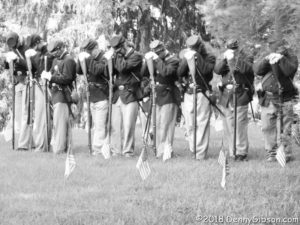 The American Civil War began with the shelling of Fort Sumter on April 12, 1861, and for the last several years we have been commemorating the 150th anniversary of events that led up to it, were part of it, and were precipitated by it. There are many theories about the origin of what we now call Memorial Day, and, while specifics vary, almost all place the roots in that devastating conflict. The most recognized story of a formal beginning places that beginning a hundred and fifty years ago on May 30, 1868.
The American Civil War began with the shelling of Fort Sumter on April 12, 1861, and for the last several years we have been commemorating the 150th anniversary of events that led up to it, were part of it, and were precipitated by it. There are many theories about the origin of what we now call Memorial Day, and, while specifics vary, almost all place the roots in that devastating conflict. The most recognized story of a formal beginning places that beginning a hundred and fifty years ago on May 30, 1868.
I attended two Memorial Day events this year. The first was a parade in nearby Loveland, and the second a gathering at Ohio’s largest cemetery, Spring Grove.

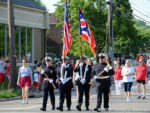 In Loveland, a police cruiser with flashing lights cleared the way with members of the local American Legion Post leading the actual parade. A group of firefighters, looking exactly like I’d want my fire department to look, was close behind. Love the mustache.
In Loveland, a police cruiser with flashing lights cleared the way with members of the local American Legion Post leading the actual parade. A group of firefighters, looking exactly like I’d want my fire department to look, was close behind. Love the mustache.

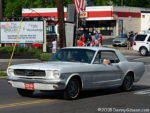
 What followed was everything a parade should have: high school marching band, classic cars, and freshly polished fire trucks. The parade ended near Veterans’ Memorial Park where ceremonies were to take place. I was watching the time, however, and left just as they were getting started.
What followed was everything a parade should have: high school marching band, classic cars, and freshly polished fire trucks. The parade ended near Veterans’ Memorial Park where ceremonies were to take place. I was watching the time, however, and left just as they were getting started.
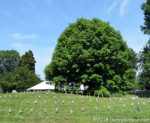 The setting for the Spring Grove ceremonies was the Civil War section where 999 Civil War dead are buried in three circular plots containing 333 graves each. These are not, of course, the only Civil War soldiers buried in the cemetery. There are 41 Civil War generals buried at Spring Grove. For the majority, however, it is an honorary (brevet) title. The cemetery’s website has some words about the war’s impact and a link to a list of those generals here.
The setting for the Spring Grove ceremonies was the Civil War section where 999 Civil War dead are buried in three circular plots containing 333 graves each. These are not, of course, the only Civil War soldiers buried in the cemetery. There are 41 Civil War generals buried at Spring Grove. For the majority, however, it is an honorary (brevet) title. The cemetery’s website has some words about the war’s impact and a link to a list of those generals here.

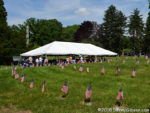 Although individual events were certainly held earlier, 1868 is the year that the observation of Decoration Day was wide spread and coordinated. That was when Grand Army of the Republic Commander, John A. Logan, issued an order calling for gatherings on May 30 “…for the purpose of strewing with flowers or otherwise decorating the graves of comrades…”. Spring Grove was one of 183 cemeteries participating that first year. There were 336 in 1869. Michigan made Decoration Day a state holiday in 1871 and other states were not far behind. It was made a federal holiday in 1888. I was unable to find a date for an official change from Decoration Day to Memorial Day. It seems to have happened somewhat naturally shortly after the first World War.
Although individual events were certainly held earlier, 1868 is the year that the observation of Decoration Day was wide spread and coordinated. That was when Grand Army of the Republic Commander, John A. Logan, issued an order calling for gatherings on May 30 “…for the purpose of strewing with flowers or otherwise decorating the graves of comrades…”. Spring Grove was one of 183 cemeteries participating that first year. There were 336 in 1869. Michigan made Decoration Day a state holiday in 1871 and other states were not far behind. It was made a federal holiday in 1888. I was unable to find a date for an official change from Decoration Day to Memorial Day. It seems to have happened somewhat naturally shortly after the first World War.
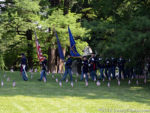
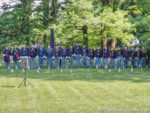
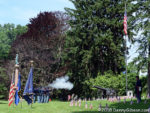 The G.A.R.’s successor, The Sons of Union Veterans of the Civil War, played a major role in the day’s activities and the 6th Ohio Volunteer Infantry helped maintain an awareness of the holiday’s Civil War era roots. They presented the colors at the beginning of the services and fired a twenty-one gun salute near their end.
The G.A.R.’s successor, The Sons of Union Veterans of the Civil War, played a major role in the day’s activities and the 6th Ohio Volunteer Infantry helped maintain an awareness of the holiday’s Civil War era roots. They presented the colors at the beginning of the services and fired a twenty-one gun salute near their end.


 Spring Grove Cemetery was barely sixteen years old when the Civil War broke out. An excerpt from Spring Grove: Celebrating 150 Years talks about the war, the cemetery, and those early Decoration Days. In describing the very first, it states that “To end the program the Ladies of the Floral Committee led the crowds around the mounds of graves, strewing them with flowers.” Today, The Auxiliary to the Sons of Union Veterans of the Civil War filled the role of the Floral Committee in helping everyone present reenact that ritual from 150 years ago.
Spring Grove Cemetery was barely sixteen years old when the Civil War broke out. An excerpt from Spring Grove: Celebrating 150 Years talks about the war, the cemetery, and those early Decoration Days. In describing the very first, it states that “To end the program the Ladies of the Floral Committee led the crowds around the mounds of graves, strewing them with flowers.” Today, The Auxiliary to the Sons of Union Veterans of the Civil War filled the role of the Floral Committee in helping everyone present reenact that ritual from 150 years ago.

I remember the time you took me to Spring Grove Cemetery (kind of interesting that I live in Spring Grove, Illinois) and saw the graves of Godfrey Weitzel (who commanded troops at the First Battle of Fort Fisher) and Joseph Hooker.
I just took a look at that post and discovered that the list of generals it refers to has gone missing. I’ve asked Spring Grove Cemetery about it but haven’t heard from them yet.